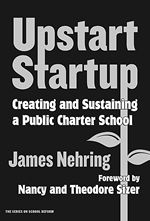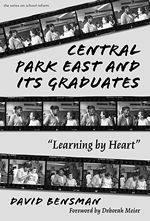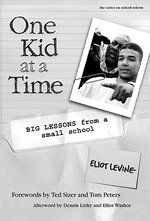 Upstart Startup: Creating and Sustaining a Public Charter School
Upstart Startup: Creating and Sustaining a Public Charter School
By James Nehring
Teachers College Press, 2002
Standards of Mind and Heart: Creating the Good High School
By Peggy Silva and Robert A. Mackin
Teachers College Press, 2002
Central Park East and Its Graduates: “Learning by Heart”
By David Bensman
Teachers College Press, 2000
 One Kid at a Time: Big Lessons from a Small School
One Kid at a Time: Big Lessons from a Small School
By Eliot Levine
Teachers College Press, 2001
“Inspiration,” “heart,” “democracy,” “models for national education reform” . . . so advertise the covers of four books from the series on small schools by Teachers College Press. True to promise, the authors deliver compelling stories of students once on the brink of academic failure who have thrived in four small schools, all based on principles from the Coalition of Essential Schools. Tony with Down’s syndrome, Tamika from a broken home, and others similarly afflicted became engaged in learning thanks to superhuman efforts from teachers and student-centered learning.
 These stories illustrate the argument in favor of creating smaller schools: students get personal attention, individualized learning plans, and grades based on long-term projects and performance-based graduation requirements. All of these schools, for example, require “senior exhibitions” for graduation, where students present project results to a panel of outside experts. Most of these schools also regularly collect portfolios of student work in an attempt to go beyond standardized test results and provide richer measures of achievement.
These stories illustrate the argument in favor of creating smaller schools: students get personal attention, individualized learning plans, and grades based on long-term projects and performance-based graduation requirements. All of these schools, for example, require “senior exhibitions” for graduation, where students present project results to a panel of outside experts. Most of these schools also regularly collect portfolios of student work in an attempt to go beyond standardized test results and provide richer measures of achievement.
This all makes small schools sound very attractive. But if small schools are to live up to their promise as national reform models and broader remedies for inequity, inspiration and heart may not be enough.
As these books demonstrate, operators of small schools share good ideas about how to make their own schools work, but they regularly ignore the fact that they have escaped from a system that prevents others from doing the same thing. Lots of educators who decide to create small schools, often by negotiating special arrangements with the local school district, do so because they don’t have any confidence that the system can be changed in any real way. Their solution has been to try to save as many kids as they can get their hands on. But they act as if anyone could do what they have done. Their denial of their own special circumstances lets them ignore—and even oppose—the system-wide changes that must occur if their valuable ideas are to be widely replicated. They rail against state standards and accountability systems, but offer few practical alternatives for ensuring that all public schools perform at a high level. Any serious reform effort must articulate a credible strategy for replicating successful schools.

Reinventing the Wheel
The strength of these four books is the honest lessons they offer people who are interested in starting new schools. Upstart Startup is the story of a Massachusetts charter school founded by Ted and Nancy Sizer (he the founder of the Coalition of Essential Schools). Hand-picked veteran teachers staff the school, and a constant stream of Harvard graduate students scrutinize its workings and volunteer their time. If any school should succeed, this is the one. Yet author James Nehring, the school’s first principal, tells a story of utter chaos in the school’s first year, including scheduling meltdowns, administrative blunders, and a failure to link course objectives with established graduation outcomes.
In Central Park East and Its Graduates, David Bensman describes similar early mistakes and regrettable incidents in the famous small school Central Park East. Now more than a decade old, at various times the school tried consensus-based governance and failed, struggled to get teachers to collaborate on instructional strategies, and butted heads over race and student favoritism.
The majority of new “small” schools are likely to make similar mistakes. The lure of building from scratch and deliberating until every teacher is happy with every decision is strong for small-school founders. And they all seem doomed to learn the same lessons in isolation. School founders have few places to turn for advice about how to avoid disaster. School districts simply do not have the expertise to help—or, worse, actively get in the way—and potential sources of technical assistance like the Coalition of Essential Schools are thinly funded and reluctant to intrude.
Inexplicably, even when lessons, resources, and help are available, school founders resist the notion of replication. Nehring’s attitude is common. He argues that efforts at replicating his program are ill advised—not even a school’s scheduling policies should be imitated. Those interested in starting their own schools are told not only to expect but also to embrace the “muddle through” strategy. Nehring argues that school reform is necessarily this messy and irreducible. By contrast, the entrepreneurial founders of the Met School in Rhode Island (as described in One Kid at a Time) have started a nonprofit to seed other Met-like schools around the country and are developing materials and assistance to make that happen.
Resistance to the idea of replication is a romantic notion that the small-schools movement and disadvantaged students cannot afford. If every school starts from scratch, the prospects are grim for reaching more than a scattered handful of students in every city. With foundations and governments willing to invest in the scaling up of promising schools, it is all the more disappointing when the books in this series fail to help answer the question of how to get beyond the boutique school and “mass produce” many smaller, personalized programs without losing the essential elements that make these schools a success?
Peggy Silva and Robert A. Mackin do believe that their small school in New Hampshire can be replicated, but their faith is misapplied. The story of Souhegan High School in New Hampshire surely describes what high schools should strive to become: oriented around creativity and questioning, designed to ensure that students are known as individuals and will be aggressively targeted for intervention if they begin to fall behind. The implication is that every large urban high school can and should be like Souhegan. Largely ignored is the fact that Souhegan was designed as a new school, not a conversion from an existing program, and in the process attracted some of the best teachers in the country.
In fact, all of the schools in this series were started as new schools, chose their teachers and are chosen by families, and have unusual operating autonomy. It is probably no coincidence that two of the four schools are charter schools. Most advocates of small schools acknowledge privately that operating as a new school and allowing students to choose to enroll are essential elements of their success. However, these realizations are usually buried in the texts of books about successful schools. Policymakers and educators are allowed to imagine that good schools can be woven out of existing bad schools and that the difficult politics of transforming schools and creating choice for families and teachers can be avoided.
There are certainly lessons about scale-up hidden in these books, and they should be used. School incubators like those running in Dayton, Sacramento, Oakland, and other cities, and nonprofit providers of technical assistance could analyze small-school start-up lessons and train new school founders to avoid common mistakes. Districts could hire staff with expertise in supporting small-school development. More schools could imitate the Met by documenting their policies and procedures to make it easy for other schools to copy what they’ve done well. Those who fear that replication efforts will produce cookie-cutter schools are right to worry, but they also have an obligation to encourage the creation of franchises that account for local context and preferences but still maintain quality controls. The need is too great to build one school at a time.
Content Is…Queen
A fundamental—and particularly controversial—aspect of the small schools described in these books is their resistance to prescribed curricular content. According to the authors, students in these schools came away with process skills adequate to allow them to become “lifelong learners.” What about learning major historical events, the U.S. Constitution and Bill of Rights, basic knowledge of life sciences, and foreign languages? Students may or may not know about these things without a defined curriculum. It all depends on whether the topics fit their interests at the time. Graduates of these schools supposedly come away with the ability to seek out whatever content is needed to address academic questions as they arise. The theory is that kids don’t retain knowledge unless the subject interests them, so why bother trying to get them to remember events and dates that they could easily look up in an encyclopedia if they ever have the need?
The authors make no bones about their disdain for those in the “content” camp, who wonder why a student should be able to graduate without knowing anything particular about history or math. Nehring, in Upstart Startup, tackles this debate most directly in his chapter titled, “Is Shakespeare Essential?” Nehring’s point is this: of course his students are exposed to content through their project-based learning, but it would be futile for people at the school, district, or state level to try to agree on what content should be required. Nehring derides, for instance, the Massachusetts charter school inspection team that dared to single out the fact that his students didn’t seem to know basic historical facts.
Souhegan High School is an exception; graduates are required to complete a core curriculum in basic areas (math, science, literature, and history). The Met School, by contrast, exhibits the extreme, with no classes, just project-based learning. The other schools teach some content, but it is integrated in teacher-crafted, theme-based modules. Despite their rhetoric, most small-school staffs clearly value content to some degree. Unfortunately, these books do not offer much new or constructive insight on how schools that emphasize process skills can also be sure their students come away with a sufficiently strong content base. In response to outside criticism, Nehring begrudgingly proposes new Essential Content to complement the school’s Essential Skills. The content list is broad enough to accommodate teachers’ judgment and creativity, and is a good and potentially useful model for basic content standards in other Coalition schools. What a shame that innovations like this are so rare and are treated as embarrassing footnotes in these books.
A more middle-ground perspective from small-school founders on the issue of content would be refreshing and productive. Surely we can agree, for instance, that skill in finding and critiquing material is valuable, especially in today’s information-overloaded Internet world. Surely we can also agree that one’s ability to interpret and critique those materials is limited without knowledge of facts.
Standard Hostility
State-mandated standards and tests are not popular in schools where every teacher individualizes content for every student. Not surprisingly, these authors devote considerable space to standards bashing. The arguments range from the persuasive (the standards are too prescriptive, are too broad, or divert attention from teaching of higher-order skills) to the absurd (the tests are beneath us). Dennis Litky (cofounder of the Met School) argues:
I know that states need to hold schools accountable in some way. . . . I’m not asking to be excused from that. What I disagree with is having one way to evaluate every student. Every state says they want students to become good thinkers, problem solvers, and citizens, but then the tests they give have almost nothing to do with those things!
There may be something to this argument, but the solution Litky presents is absurdly subjective: every school should be able to devise its own standards and ways of showing it is achieving what the state claims to value. He writes, “We could videotape every exhibition and the state could randomly select and assess a sample of them.” Litky and his fellow small schoolers can make these claims more reasonably than other schools, since most small schools are schools of choice. Thus they face an even tougher form of accountability than state standards and tests: the ability of parents and students to leave the school if they aren’t satisfied.
Nevertheless, whether or not the authors share legitimate complaints about the constraints that standards place on their professional judgment, the “leave us to our rubrics” attitude marginalizes the small-schools movement. The authors offer thin evidence of whether their schools are in fact teaching and assessing content knowledge and skills in the ways they promise. All four books offer reasonably strong evidence that these schools are keeping kids from dropping out, getting them into college, and helping them do well on standardized reading tests. But descriptions of school-based outcomes and assessments in these schools raise troubling doubts. Litky again:
Do we require a minimum proficiency level? I’d like to say that we wouldn’t graduate a student with a 6th-grade reading level. But on the other hand, there aren’t even any measures that assess reading ability very well.
Even if we buy the idea that teachers at the Met are so talented that they should be trusted to demand high performance from every student, what about schools with less skilled teachers and lower expectations? These are the schools that standards, standardized assessments, and state accountability systems are designed to identify and fix. By failing to take the need for states to address this problem seriously, small-schools advocates seem to ignore the broader issues of social justice that they work so hard to address in their own schools.
Instead of devoting so much energy to dismissing the standards movement, small-schools founders and advocates would do well to engage the discussion and help refine or redefine state standards and statewide accountability systems in the name of equity. Schools based on inspiration and heart may be enough for reformers who are willing to settle for localized quality and impact, but the small-schools advocates I know aspire to a lot more. They believe true equity depends on universal access to good public schools. For that to happen, small schools must mature into a stronger movement by formulating serious proposals for assessments and accountability, throwing their vocal political support behind school choice, and insisting on new, innovative efforts to reduce the learning curve for those who wish to start small schools and their overseers.
-Robin J. Lake is associate director of the Center on Reinventing Public Education at the University of Washington.


